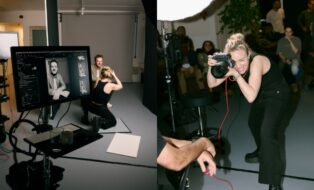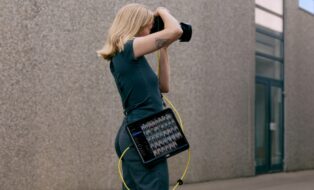NOTE: This article discusses an outdated version of Capture One. To learn more about our latest version, click here.
A popular question line in many of our webinars on Capture One often concerns cropping. For example, “How do I crop to specific dimensions?’ or “How do I crop to a certain width in Cm/Inches/Pixels”.
In this blog post I will run through a couple of examples and golden rules, which you can apply to your own workflow.
A golden rule
When cropping, it is worth keeping in mind that cropping dimensions and other factors are directly related to the currently selected recipe, in the Process Recipes tool.
In the first example below, the recipe ‘TIFF 8 Bit Full Size (Adobe RGB)’ is selected. Notice that the Scale option in the Basic tab of the Process Recipe tool is set to Fixed and 100%.
Then, if we look at our cropping values in the Capture One viewer, the pixel dimensions show that Capture One is simply cropping to the maximum possible resolution. (These cropping Labels can be disabled in the Capture One Preferences if you would prefer not to see them, but they are useful!)
Now, if I choose recipe where the scale is somehow changed, in this case limiting the number of pixels to a certain value on an edge, then the pixel values in the crop will reflect that also.
So, hopefully you will consider this as a clue as to how we can crop to specific dimensions by linking the Crop tool to the Process Recipe. But more on that later, let’s start simple.
Often the most you need to do when cropping is to honor a certain aspect ratio. This is very simple to achieve. With the new quick cursor tools in Capture One 8.1, this is even simpler – with the Crop tool selected, simply right- or control-click.
Then choose the aspect ration in the Ratio drop down menu.
So, for example, if we needed a 2×3 output we would choose it accordingly. Usefully, it is not necessary to have a portrait or landscape aspect ratio. The crop will ‘snap’ to either if you choose to give priority to a landscape or portrait crop.
New Aspect Ratios can be created by choosing the first option in the same menu.
This method can be used for creating outputs that fit into an aspect ratio. For example, you can make an aspect ratio set to ’10 x 8’ for producing 10 inch by 8 inch prints, knowing that it will be the right ratio to print to that size, if you are prepared to let the print engine resize to the actual dimensions. There is nothing wrong with that method, especially if you may want to print larger at a point in time, but if that is not the case, then you are creating too large an output for the task at hand.
If you want to link the Crop tool to the currently selected Process Recipe, then it’s very simple. In the available options in the above Ratio menu, choose Output.
The next part is to change the scaling options in the Process Recipe tool to specific dimensions.
Now, when the Crop tool is used, with that Recipe selected the Crop tool will always crop to the correct aspect ratio and output to the correct dimensions.
If you have ever seen that one of the crop labels is marked in red, this usually means that the Crop tool aspect ratio has not be set to Output, and therefore mismatches the Recipe, or the required output is not possible in terms of available resolution or Capture One’s scaling restraints.
The possibilities of cropping in this method are not limited to exact dimensions. If you take a look in the Scale drop down menu, several other options are possible. For example, limiting the long or short edge to a certain number of pixels has lots of uses in web size requirements.
This is another reason why it is worth exercising the full possibilities in a Process Recipe. It can save you huge amounts of time and improve the quality of output.
Best regards,
David Grover
David Grover
David Grover is part of the Capture One team, bringing you help, advice and education on a variety of subjects and platforms. David can be found on most weeks delivering live Capture One Webinars or anytime on our YouTube Channel.














Thank you David
I’d really like to be able to filter variants by aspect ratio. For example, I like to show landscape images online in 16:9, but that isn’t practical for print. So I have to do an alternative crop for 2:3 (for example).
The ability to filter by aspect ratio would be very handy. Also, orientation too. In fact, it would be great if there was a file naming ticket to include the ratio in the file name of exported files.
An FYI for prints:
When cropping for a custom print, I use the unconstrained setting first. After I feel satisfied with the basic look, I switch to a preset ratio in Capture One that is closest to a “normal” print size ratio and fine tune it.
Many print companies often run sales on certain stock sizes. Doing this saves a lot of cash and I get very close to the custom print size I wanted in the first place.
Very helpfull, thanks.
Much thanks David. This is timely information for me as I’m working on a proposal where time is critical to making the job a financial success. This tip will now be integrated into my workflow, making my bottom line more attractive. 🙂
Thanks a lot David for this tutorial.
I’m wondering, if the sharpening settings are in sync after cropping to specific dimension (e.g. vor Social Media). Or do I have to sharpen the image after exporting?
BTW: A tutorial for a sharpening workflow would be great!
Hey Ingo,
You’re welcome!
The sharpening is not scaled, so you might like to check? But in my experience, I do not feel the need to sharpen after export.
David
Hi David,
Am I able to crop using Capture One during live tethering? I need to be able to take multiple images of the same size, but I need to line each photo up to this size individually.
If not am I able to apply a crop recipe to multiple images after they have been taken? This will be slightly more inaccurate – but still usefull.
Thanks!
Hi Nicola,
Yes, you can do both.
David
Is there a way to export cropping guides to s tiff without actually cropping the image? I’m retouching images at a different location than the art director, who is looking for a shortcut to convey cropping guides.
Hi Tom,
Not directly in capture one. Why not send him the RAW file with crop applied?
David
The art director is working remotely at the shoot. To convey the crops to me, she has to do a screen grab of every shot and email it. Being able to save crop marks in Capture one would be a nice addition to a future release.
Hi David,
Thank you for this tutorial. Can you tell us more about ressampling algorithm associated with recipes dimensions used by c1. For printing purpose, is it better to resize in PS ?
Best regards,
Hi Antoine,
Thanks for your question.
When scaling between the range of 50 to 250 percent, our rescaled is top notch. For large reduction in size you may sometimes benefit from doing the resizing in Photoshop. This is an area we are looking into.
All the best,
Niels
Hi David,
Another question. Is it possible to link a given image/variant with a specific recipe ?
When you select one recipe all the images you browse are affected.
Best regards,
Hi Antoine,
Its the currently displayed collection. So if you have filtered your collection of images, then those will only be affected.
David
I am trying to remember when using the crop tool, when creating a new crop dimension, if it is necessary to add 100 to the dimension. I.e, to get 8 x 10, you type 800 x 1000. I remember someone telling me that and this is supposedly how it is done.
If you are talking about Ratio, then it doesn’t matter wether it is 8 x 10, 800 x 1000 or 80 x 100. Its simply a ratio between a to b.
Hi, I have been trying to create a preset crop ratio of 6×4.5cm. Of course the phase one backs are all 6×4.5, so you could just select “original” but say if you were mixing in a 35mm in a few shots and want to easily crop it down to the same ratio, it seems difficult to set any ratio with half values. Any advice?
60 x 45?
Hi, I have set the process recipe to 60x40cm @ 300dpi. The cropping tool is set to ‘output’. When I crop, sometimes the crop snaps to the correct dimensions and sometimes one side will be 39.99cm(red). I have to fiddle to get this correct. Why is this? Am doing something wrong? Thanks Neil
Hi – I was curious if there is a quick way to reset the crop to the unedited state? I see a way to reset the whole image edits, but I’d like to find a shortcut to reset the crop quickly. Thanks.
Hi Boone,
There is no Crop reset, but you can hold down SHIFT and draw a new crop. That will disregard the old one.
Thanks for the quick reply. That would be a nice feature down the road. Also same thing for rotating.
I’ve used C1 for tethering plenty but I’m finally getting around to using it for all my RAW processing. Just trying to get the workflow and custom keyboard shortcuts exactly how I want them. Cheers.
Hi.
Is there a way to temporarily lock the aspect ratio with a shortcut, while searching for the crop in unconstrained mode?
As in photoshop using the crop tool and holding down the shift key will lock the aspect ratio.
Hi Maarten,
No not currently, but thanks for your feedback.
David, I’ve been watching your videos on Creative Live. They are quite excellent. Right now I’m needing to crop a bunch of images to 3:2. Works great on large images, but I have a bunch of little images, less than 600px, and when I try to use the crop tool on those images it is disabled. What am I doing wrong?
Hi Alec,
There is a minimum limit for Capture One to edit an image. Sounds like these are very small Jpegs, so I am assuming that’s the reason why.
And thanks for your kind comments – I am glad they are helping!
David